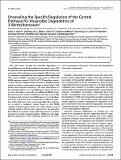Por favor, use este identificador para citar o enlazar a este item:
http://hdl.handle.net/10261/116673COMPARTIR / EXPORTAR:
 SHARE SHARE
 CORE
BASE CORE
BASE
|
|
| Visualizar otros formatos: MARC | Dublin Core | RDF | ORE | MODS | METS | DIDL | DATACITE | |

| Título: | Unraveling the specific regulation of the central pathway for anaerobic degradation of 3-methylbenzoate. |
Autor: | Juárez, Javier F. CSIC; Liu, Huixiang; Zamarro, María Teresa CSIC; McMahon, Stephen; Liu, Huanting; Naismith, James H.; Eberlein, C.; Boll, Matthias; Carmona, Manuel CSIC ORCID ; Díaz, Eduardo CSIC ORCID | Palabras clave: | Transcriptional regulation Azoarcus Anaerobic degradation 3-methylbenzoate |
Fecha de publicación: | 8-may-2015 | Editor: | American Society for Biochemistry and Molecular Biology | Citación: | J Biol Chem. 290(19):12165-83 (2015) | Resumen: | The mbd cluster encodes the anaerobic degradation of 3-methylbenzoate in the β-proteobacterium Azoarcus sp. CIB. The specific transcriptional regulation circuit that controls the expression of the mbd genes was investigated. The PO, PB 1, and P3 R promoters responsible for the expression of the mbd genes, their cognate MbdR transcriptional repressor, as well as the MbdR operator regions (ATACN10GTAT) have been characterized. The three-dimensional structure of MbdR has been solved revealing a conformation similar to that of other TetR family transcriptional regulators. The first intermediate of the catabolic pathway, i.e. 3-methylbenzoyl-CoA, was shown to act as the inducer molecule. An additional MbdR-dependent promoter, PA, which contributes to the expression of the CoA ligase that activates 3-methylbenzoate to 3-methylbenzoyl-CoA, was shown to be necessary for an efficient induction of the mbd genes. Our results suggest that the mbd cluster recruited a regulatory system based on the MbdR regulator and its target promoters to evolve a distinct central catabolic pathway that is only expressed for the anaerobic degradation of aromatic compounds that generate 3-methylbenzoyl-CoA as the central metabolite. All these results highlight the importance of the regulatory systems in the evolution and adaptation of bacteria to the anaerobic degradation of aromatic compounds. | Descripción: | 19 p.-9 fig.-3 tab. | Versión del editor: | http://dx.doi.org/10.1074/jbc.M115.637074 | URI: | http://hdl.handle.net/10261/116673 | DOI: | 10.1074/jbc.M115.637074 | ISSN: | 0021-9258 | E-ISSN: | 1083-351X |
| Aparece en las colecciones: | (CIB) Artículos |
Ficheros en este ítem:
| Fichero | Descripción | Tamaño | Formato | |
|---|---|---|---|---|
| JBC 2015.pdf | 5,65 MB | Adobe PDF |  Visualizar/Abrir |
CORE Recommender
PubMed Central
Citations
3
checked on 20-abr-2024
SCOPUSTM
Citations
7
checked on 24-abr-2024
WEB OF SCIENCETM
Citations
7
checked on 25-feb-2024
Page view(s)
245
checked on 23-abr-2024
Download(s)
269
checked on 23-abr-2024
Google ScholarTM
Check
Altmetric
Altmetric
Artículos relacionados:
NOTA: Los ítems de Digital.CSIC están protegidos por copyright, con todos los derechos reservados, a menos que se indique lo contrario.
